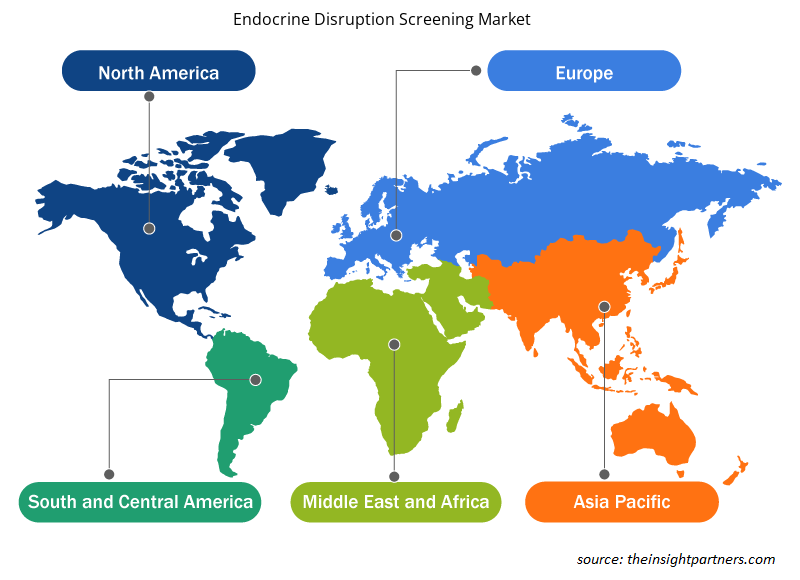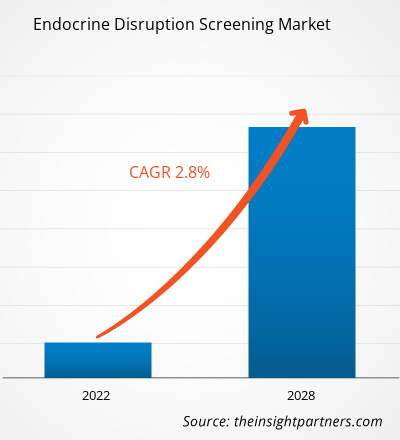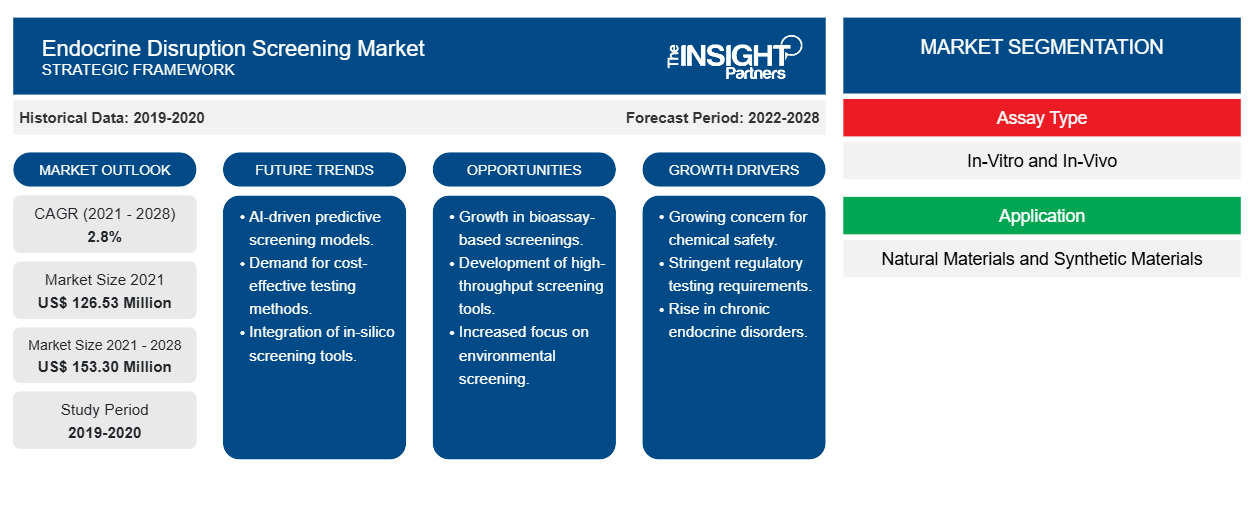Der Markt für Screenings auf endokrine Disruptoren soll von 126,53 Millionen US-Dollar im Jahr 2021 auf 153,30 Millionen US-Dollar im Jahr 2028 anwachsen; für den Zeitraum von 2021 bis 2028 wird mit einer durchschnittlichen jährlichen Wachstumsrate von 2,8 % gerechnet.CAGR of 2.8% during 2021 to 2028.
Viele Chemikalien, sowohl natürliche als auch künstliche, können das endokrine System, das die Hormone des Körpers reguliert, nachahmen oder beeinträchtigen. Diese Chemikalien, bekannt als endokrine Disruptoren, werden mit Entwicklungs-, Fortpflanzungs-, Gehirn-, Immun- und anderen Störungen in Verbindung gebracht. Endokrine Disruptoren können in einer Vielzahl von Alltagsgegenständen vorhanden sein, beispielsweise in einigen Plastikflaschen und -behältern, Metalldosenauskleidungen für Lebensmittel, Reinigungsmitteln, Flammschutzmitteln, Lebensmitteln, Spielzeugen, Kosmetika und Pestiziden. Pestizide, Chemikalien und Umweltgifte werden im Rahmen des endokrinen Disruptor-Screenings mit einer zweistufigen Methode auf ihre möglichen Auswirkungen auf das Östrogen-, Androgen- und Schilddrüsenhormonsystem untersucht.
Das Wachstum des Marktes für Screenings endokriner Störungen ist auf die zunehmende Forschung im Biotechnologiesektor und die steigende Prävalenz endokriner Störungen zurückzuführen. Die hohen Kosten der Screening-Technologie hemmen jedoch das Marktwachstum.
Passen Sie diesen Bericht Ihren Anforderungen an
Sie erhalten kostenlos individuelle Anpassungen an jedem Bericht, einschließlich Teilen dieses Berichts oder einer Analyse auf Länderebene, eines Excel-Datenpakets sowie tolle Angebote und Rabatte für Start-ups und Universitäten.
- Holen Sie sich die wichtigsten Markttrends aus diesem Bericht.Dieses KOSTENLOSE Beispiel umfasst eine Datenanalyse von Markttrends bis hin zu Schätzungen und Prognosen.
Markteinblicke:
Die zunehmende Verbreitung endokriner Störungen treibt den Markt für Screenings auf endokrine Störungen an
Akromegalie (Überproduktion von Wachstumshormonen), Fettleibigkeit, Metabolisches Syndrom, gestörter Nüchternblutzucker, gestörte Glukosetoleranz, Osteoporose, Osteopenie, leichte bis mittelschwere Hypovitaminose D, Erektionsstörungen, Dyslipidämie und Thyreoiditis gehören zu den endokrinen Erkrankungen, die in den USA bei Erwachsenen insgesamt mindestens 5 % der Bevölkerung betreffen. Von diesen Erkrankungen ist die Erektionsstörung bei Männern am häufigsten, während Osteopenie/Osteoporose bei Frauen am häufigsten auftritt. Diabetes mellitus bei Kindern und Hypophysenadenom sind die seltensten Erkrankungen und betreffen weniger als 1 % der US-Bevölkerung. Nebennierenrindenkarzinom, Phäochromozytom und Hypophysenadenom sind die Erkrankungen mit der geringsten Inzidenz. Hyperparathyreoidismus und Schilddrüsenerkrankungen kommen bei Frauen häufiger vor. Diabetes mellitus tritt am häufigsten bei ethnischen Minderheiten auf. (overproduction of growth hormone), obesity, metabolic syndrome, impaired fasting glucose, impaired glucose tolerance, osteoporosis, Endokrine und metabolische Erkrankungen zählen zu den häufigsten modernen menschlichen Leiden, insbesondere in den USA und anderen Ländern, in denen umfangreiche Ernährungs- und Screeningprogramme für Hochrisikopersonen durchgeführt werden. Endokrine Störungen wie Hyperparathyreoidismus, primärer und sekundärer Hypogonadismus, Wachstumshormonmangel und Hypothyreose können zu anderen Erkrankungen wie metabolischen Knochenerkrankungen und Diabetes mellitus führen. Die zunehmende Verbreitung und Inzidenz solcher Erkrankungen treibt daher die Nachfrage nach Screeningprodukten für endokrine Störungen voran.osteopenia, mild-moderate hypovitaminosis D, erectile dysfunction, dyslipidemia, and thyroiditis are among the endocrine disorders that have a collective prevalence of at least 5% among the adults in the US. Of these conditions, Males have the highest incidence of erectile dysfunction, while females have the highest incidence of osteopenia/osteoporosis. Diabetes mellitus in children and pituitary adenoma are the least common conditions, affecting less than 1% of the US population. Adrenocortical carcinoma, pheochromocytoma, and pituitary adenomas are the conditions with the lowest incidence. Hyperparathyroidism and thyroid disorders are more common in women. Diabetes mellitus is most prevalent among ethnic minorities. hypogonadism, GH deficiency, and hypothyroidism can lead to other disorders, such as metabolic bone disease and diabetes mellitus. Thus, the growing prevalence and incidence of such conditions propel the demand for endocrine disruption screening products.
Erkenntnisse basierend auf Assay-Typen
Der Markt für Screenings auf endokrine Disruptoren ist nach Testtyp in In-vitro und In-vivo unterteilt. Das In-vitro-Segment war 2021 Marktführer mit einem Marktanteil von 64,45 % und wird voraussichtlich im Prognosezeitraum seine Dominanz beibehalten und 2028 einen Marktanteil von 65,73 % des Gesamtumsatzes erreichen.in-vitro and in-vivo. The in-vitro segment led the market in 2021, contributing to a market share of 64.45%, and is expected to retain its dominance during the forecast period to account for a market share of 65.73% of the overall revenue generated in 2028.
Anwendungsbasierte Erkenntnisse
Nach Anwendung ist der Markt für Screenings auf endokrine Disruptoren in natürliche und synthetische Materialien unterteilt. Im Jahr 2021 hielt das Segment der natürlichen Materialien einen größeren Marktanteil. Darüber hinaus wird erwartet, dass der Markt für dasselbe Segment im Zeitraum 2021–2028 mit einer schnelleren durchschnittlichen jährlichen Wachstumsrate von 3,1 % wächst.CAGR of 3.1% during 2021–2028.
Quelle für abfallbasierte Erkenntnisse
Der Markt für Screenings endokriner Disruptoren ist nach Abfallquellen segmentiert in Verbrennung und Deponie, landwirtschaftliche Abwässer, industrielle und kommunale Abwässer, Abwässer aus Zellstofffabriken, Konsumgüter und andere. Im Jahr 2021 hielt das Segment Verbrennung und Deponie den größten Marktanteil. Darüber hinaus wird erwartet, dass der Markt für dasselbe Segment im Zeitraum 2021–2028 mit einer durchschnittlichen jährlichen Wachstumsrate von 3,5 % am schnellsten wächst.
Methodenbasierte Erkenntnisse
Der Markt für Screenings endokriner Störungen ist nach Methode segmentiert in Östrogenrezeptor (ER)-Transaktivierung, Androgenrezeptor (AR)-Transaktivierung, Androgenrezeptor (AR)-Modulation, Östrogenrezeptor-Alpha (ER)-Bindung, Östrogenrezeptor-Beta (ER)-Bindung, Androgenrezeptor (AR)-Bindung, Steroidogenese, Aromatasetest und andere. Im Jahr 2021 hielt das Segment Östrogenrezeptor (ER)-Transaktivierung den größten Marktanteil. Darüber hinaus wird erwartet, dass der Markt für dasselbe Segment von 2021 bis 2028 mit der schnellsten CAGR von 3,7 % wächst.transactivation, androgen receptor (AR) transactivation, androgen receptor (AR) modulation, estrogen receptor-alpha (ER) binding, estrogen receptor beta (ER) binding, androgen receptor (AR) binding, steroidogenesis, aromatase assay, and others. In 2021, the estrogen receptor (ER) transactivation segment held the largest share of the market. Moreover, the market for the same segment is expected to grow at the fastest CAGR of 3.7% from 2021 to 2028.
Endbenutzerbasierte Erkenntnisse
Der Markt für Screenings auf endokrine Disruptoren ist je nach Endverbrauch in Pharma- und Biopharmaunternehmen, Kosmetik- und Haushaltsproduktunternehmen, die Lebensmittelindustrie und die chemische Industrie unterteilt. Im Jahr 2021 hielt das Segment der Pharma- und Biopharmaunternehmen den größten Marktanteil. Darüber hinaus wird erwartet, dass der Markt für dasselbe Segment im Zeitraum 2021–2028 mit einer durchschnittlichen jährlichen Wachstumsrate von 3,3 % am schnellsten wächst.biopharmaceutical companies, cosmetics and household product companies, food industry, and chemical industry. In 2021, the pharmaceutical and biopharmaceutical companies segment held the largest share of the market. Moreover, the market for the same segment is expected to grow at the fastest CAGR of 3.3% during 2021–2028.
Produkteinführungen und -zulassungen sind häufig von Unternehmen angewandte Strategien, um ihre globale Präsenz und ihr Produktportfolio zu erweitern. Darüber hinaus konzentrieren sich die Akteure auf dem Markt für Hormonscreenings auf die Partnerschaftsstrategie, um ihren Kundenstamm zu vergrößern, was ihnen wiederum ermöglicht, ihren Markennamen weltweit aufrechtzuerhalten.
Regionale Einblicke in den Markt für Screenings zur endokrinen Störung
Die regionalen Trends und Faktoren, die den Markt für endokrin wirksame Screenings im Prognosezeitraum beeinflussen, wurden von den Analysten von Insight Partners ausführlich erläutert. In diesem Abschnitt werden auch die Marktsegmente und die Geografie für endokrin wirksame Screenings in Nordamerika, Europa, im asiatisch-pazifischen Raum, im Nahen Osten und Afrika sowie in Süd- und Mittelamerika erörtert.

- Erhalten Sie regionale Daten zum Markt für Screenings auf endokrine Störungen
Umfang des Marktberichts zum Screening endokriner Störungen
| Berichtsattribut | Details |
|---|---|
| Marktgröße im Jahr 2021 | 126,53 Millionen US-Dollar |
| Marktgröße bis 2028 | 153,30 Millionen US-Dollar |
| Globale CAGR (2021 - 2028) | 2,8 % |
| Historische Daten | 2019-2020 |
| Prognosezeitraum | 2022–2028 |
| Abgedeckte Segmente | Nach Testtyp
|
| Abgedeckte Regionen und Länder | Nordamerika
|
| Marktführer und wichtige Unternehmensprofile |
|
Marktteilnehmerdichte: Der Einfluss auf die Geschäftsdynamik
Der Markt für Screenings auf endokrine Störungen wächst rasant, angetrieben von der steigenden Nachfrage der Endnutzer aufgrund von Faktoren wie sich entwickelnden Verbraucherpräferenzen, technologischen Fortschritten und einem größeren Bewusstsein für die Vorteile des Produkts. Mit steigender Nachfrage erweitern Unternehmen ihr Angebot, entwickeln Innovationen, um die Bedürfnisse der Verbraucher zu erfüllen, und nutzen neue Trends, was das Marktwachstum weiter ankurbelt.
Die Marktteilnehmerdichte bezieht sich auf die Verteilung der Firmen oder Unternehmen, die in einem bestimmten Markt oder einer bestimmten Branche tätig sind. Sie gibt an, wie viele Wettbewerber (Marktteilnehmer) in einem bestimmten Marktraum im Verhältnis zu seiner Größe oder seinem gesamten Marktwert präsent sind.
Die wichtigsten Unternehmen auf dem Markt für Screenings zur endokrinen Störung sind:
- KREATIVES BIOARRAY
- XENOMETRIX AG
- CHARLES RIVER
- EUROFINS SCIENTIFIC
- SCHMIEDE
Haftungsausschluss : Die oben aufgeführten Unternehmen sind nicht in einer bestimmten Reihenfolge aufgeführt.

- Überblick über die wichtigsten Akteure auf dem Markt für endokrinologische Screenings
Der Bericht segmentiert den Markt für Hormonscreenings wie folgt
Markt für Screenings endokriner Störungen – nach Testtyp
- In-Vitro
- In-Vivo
Markt für Screenings endokriner Störungen – nach Anwendung
- Natürliche Materialien
- Synthetische Materialien
Markt für Screenings endokriner Störungen – nach Abfallquellen
- Verbrennung und Deponierung
- Landwirtschaftlicher Abfluss
- Industrielle und kommunale Abwässer
- Abwässer aus Zellstofffabriken
- Verbraucherprodukte
- Sonstiges
Markt für Screenings endokriner Störungen – nach Methode
- Transaktivierung des Östrogenrezeptors (ER).
- Transaktivierung des Androgenrezeptors (AR)
- Androgenrezeptor (AR)-Modulation
- Östrogenrezeptor-Alpha (ER-alpha)-Bindung
- Bindung des Östrogenrezeptors Beta (ER-beta).
- Androgenrezeptor (AR)-Bindung
- Steroidogenese
- Aromatase-Assay
- Sonstiges
Markt für Screenings auf endokrine Störungen – nach Endverbraucher
- Pharmazeutische und biopharmazeutische Unternehmen
- Chemische Industrie
- Lebensmittelindustrie
- Kosmetik- und Haushaltsproduktunternehmen
Markt für Screenings auf endokrine Störungen – nach Geografie
- Nordamerika
- UNS
- Kanada
- Mexiko
- Europa
- Vereinigtes Königreich
- Deutschland
- Frankreich
- Italien
- Spanien
- Restliches Europa
- Asien-Pazifik
- China
- Japan
- Indien
- Australien
- Südkorea
- Restlicher Asien-Pazifik-Raum
- Naher Osten und Afrika
- Vereinigte Arabische Emirate
- Saudi-Arabien
- Südafrika
- Restlicher Naher Osten und Afrika
- Süd- und Mittelamerika
- Brasilien
- Argentinien
- Restliches Süd- und Mittelamerika
Firmenprofile
- KREATIVES BIOARRAY
- XENOMETRIX AG
- CHARLES RIVER LABORATORIES, INC.
- EUROFINS SCIENTIFIC Ltd.
- SCHMIEDE
- SGS SA
- JRF GLOBAL
- Mérieux Nutrisciences
- ALPHA ANALYTICAL INC.
- Historische Analyse (2 Jahre), Basisjahr, Prognose (7 Jahre) mit CAGR
- PEST- und SWOT-Analyse
- Marktgröße Wert/Volumen – Global, Regional, Land
- Branchen- und Wettbewerbslandschaft
- Excel-Datensatz
Aktuelle Berichte
Erfahrungsberichte
Grund zum Kauf
- Fundierte Entscheidungsfindung
- Marktdynamik verstehen
- Wettbewerbsanalyse
- Kundeneinblicke
- Marktprognosen
- Risikominimierung
- Strategische Planung
- Investitionsbegründung
- Identifizierung neuer Märkte
- Verbesserung von Marketingstrategien
- Steigerung der Betriebseffizienz
- Anpassung an regulatorische Trends





















 Kostenlose Probe anfordern für - Markt für Screenings auf endokrine Störungen
Kostenlose Probe anfordern für - Markt für Screenings auf endokrine Störungen